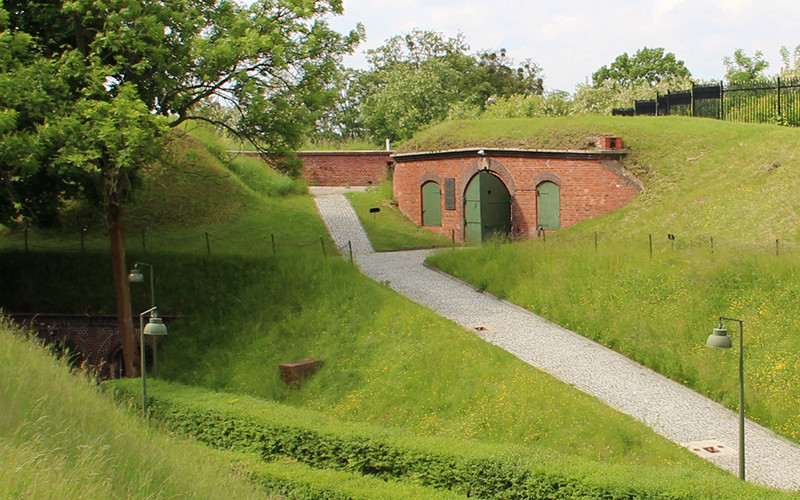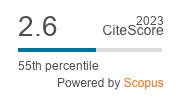Impact of danger, legibility and mystery on visitor’s preference in fortified landscapes compared with park landscapes in urban areas
DOI:
https://doi.org/10.3097/LO.2023.1118Keywords:
Landscape Perception, Green Areas, Urban Parks, Heritage Landscapes, Environmental Psychology, Heritage ProtectionAbstract
Both the parks and historical fortifications constitute important components of urban green spaces in many cities around the world. The approach taken in terms of shaping these spaces often appears similar regardless of provenance. For this reason, recognising the preferences of their visitors is relevant from the perspective of creating and managing spaces that are not only safe, but also interesting. In this study we were interested in how fortress landscapes are perceived compared with typical urban parks in Poland. To this end, we conducted a questionnaire involving 117 participants who evaluated a set of 116 eye-level photographs (58 fortified landscapes and 58 urban parks environments). We analysed a range of correlations and mediation models, testing hypotheses regarding the mediating role of mystery, legibility and danger on preferences towards the two types of studied landscapes. We wished to establish what hidden mechanisms underpin the studied variables as well as their influence on the shaping of the researched landscapes. The results indicate that in the case of fortified landscape, it is important to maintain greenery favoured by the respondents, conducive to diversity and mystery while limiting perceived danger. Legibility can support educational values in the protection and maintenance of fortifications when sites are not devoid of mystery. In the case of park landscapes, legibility should not be improved at the expense of a complete loss of mystery, but should be accompanied by a reduction in perceived danger. In turn, mystery in parks plays an important role because without it, even legible park landscapes cease to be liked by the respondents. In turn, in fortress landscapes, mystery has a strong impact on preference, regardless of its relation to danger and legibility. At the same time, were it not for the fact that legibility reduces sense of danger, legible fortress landscapes would not be liked. Therefore, our findings can support the successful restoration and maintenance of fortress landscapes especially when their function shifts and they need to be managed and maintained in a planned manner in modern green areas.
References
Armand, D., 2017. Re-designing Urban Stream Land- scape by Investigating the Citizens’ Preference Ma- trix. Civil Engineering and Architecture 5, 152–160. https://doi.org/10.13189/cea.2017.050404 DOI: https://doi.org/10.13189/cea.2017.050404
Bogucka, Z., 2021. The Nonvisual Legibility and the Coherence of Space: A New Theoretical Framework with Examples of Its Implementation in Empiri- cal Research. Loci Communes 1, 1–39. https://doi.org/10.31261/LC.2021.01.02 DOI: https://doi.org/10.31261/LC.2021.01.02
Fischer, L.K., Honold, J., Cvejić, R., Delshammar, T., Hilbert, S., Lafortezza, R., Nastran, M., Nielsen, A.B., Pintar, M., van der Jagt, A.P.N., Kowarik, I., 2018. Beyond green: Broad support for biodiversity in multicultural European cities. Global Environmental Change 49, 35–45. https://doi.org/10.1016/j.gloenvcha.2018.02.001 DOI: https://doi.org/10.1016/j.gloenvcha.2018.02.001
Fisher, B., Nasar, J.L., 1992. Fear of crime in relation to three exterior site features: Prospect, refuge, and escape. Environment and Behavior 35–65. https://doi.org/10.1177/0013916592241002 DOI: https://doi.org/10.1177/0013916592241002
Fuller, R., Irvine, K., Devine-Wright, P., Warren, P., Gaston, K., 2007. Psychological benefits of greenspace increase with biodiversity. Biology Letters 3, 390–394. https://doi.org/10.1098/rsbl.2007.0149 DOI: https://doi.org/10.1098/rsbl.2007.0149
George, D., Mallery, P., 2016. IBM SPSS Statistics 23 Step by Step: A Simple Guide and Reference (14th ed.). Routledge, New York.
Gimblett, H.R., Itami, R.M., Fitzgibbon, J.E., 1985. Mystery in an Information Processing Model of Landscape Preference. Landscape Journal 4, 87–95. DOI: https://doi.org/10.3368/lj.4.2.87
Gunnarsson, B., Hedblom, M., 2023. Biophilia revisited: nature versus nurture. Trends in Ecology & Evolution. https://doi.org/10.1016/j.tree.2023.06.002 DOI: https://doi.org/10.1016/j.tree.2023.06.002
Harris, V., Kendal, D., Hahs, A.K., Threlfall, C.G., 2018. Green space context and vegetation complexity shape people’s preferences for urban public parks and residential gardens. Landscape Research 43, 150–162. https://doi.org/10.1080/01426397.2017.1302571 DOI: https://doi.org/10.1080/01426397.2017.1302571
Herzog, T., Smith, G.A., 1988. Danger, Mystery, and Environmental Preference. Environment and Behavior 20, 320–344. https://doi.org/10.1177/0013916588203004 DOI: https://doi.org/10.1177/0013916588203004
Herzog, T.R., 1989. A cognitive analysis of preference for urban nature. Journal of Environmental Psychology 9, 27–42. https://doi.org/10.1016/S0272-4944(89)80024-6 DOI: https://doi.org/10.1016/S0272-4944(89)80024-6
Herzog, T.R., Bryce, A.G., 2007. Mystery and Preference in Within-Forest Settings. Environment and Behavior 39, 779–796. https://doi.org/10.1177/0013916506298796 DOI: https://doi.org/10.1177/0013916506298796
Herzog, T.R., Flynn-Smith, J.A., 2001. Preference and perceived danger as a function of the perceived curvature, length and width of urban alleys. Environment and Behavior 33, 655–668. https://doi.org/10.1177/00139160121973179 DOI: https://doi.org/10.1177/00139160121973179
Herzog, T.R., Kaplan, S., Kaplan, R., 1982. The prediction of preference for unfamiliar urban places. Population and Environment 5, 43–59. https://doi.org/10.1007/BF01359051 DOI: https://doi.org/10.1007/BF01359051
Herzog, T.R., Kirk, K.M., 2005. Pathway curvature and border visibility as predictors of preference and danger in forest settings. Environment and Behavior 37, 620–639. https://doi.org/10.1177/0013916505275306 DOI: https://doi.org/10.1177/0013916505275306
Herzog, T.R., Kropscott, L.S., 2004. Legibility, mystery, and visual access as predictors of preference and perceived danger in forest settings without pathways. Environment and Behavior 36, 659–677. DOI: https://doi.org/10.1177/0013916504264138
Herzog, T.R., Kutzli, G.E., 2002. Preference and perceived danger in field/forest settings. Environment and Behavior, 34, 858–874. https://doi.org/10.1177/00139160121973179 DOI: https://doi.org/10.1177/001391602237250
Herzog, T.R., Leverich, O.L., 2003. Searching for legibility. Environment and Behavior 459–477. DOI: https://doi.org/10.1177/0013916503035004001
Herzog, T.R., Miller, E.J., 1998. The Role of Mystery in Perceived Danger and Environmental Preference. Environment and Behavior 30, 429–449. https://doi.org/10.1177/001391659803000401 DOI: https://doi.org/10.1177/001391659803000401
Hofmann, M., Westermann, J.R., Kowarik, I., van der Meer, E., 2012. Perceptions of parks and urban derelict land by landscape planners and residents. Urban Forestry & Urban Greening 11, 303–312. https://doi.org/10.1016/j.ufug.2012.04.001 DOI: https://doi.org/10.1016/j.ufug.2012.04.001
Holm, S., 1979. A Simple Sequentially Rejective Multiple Test Procedure. Scandinavian Journal of Statistics 6, 65–70.
Hoyle, H., Hitchmough, J.D., Jorgensen, A., 2017. All about the ‘wow factor’? The relationships between aesthetics, restorative effect and perceived biodiversity in designed urban planting. Landscape and Urban Planning 164, 109–123. DOI: https://doi.org/10.1016/j.landurbplan.2017.03.011
Hølleland, H., Skrede, J., Holmgaard, S.B., 2017. Cultural Heritage and Ecosystem Services: A Literature Review. Conservation and Management of Archaeological Sites 19, 210–237. https://doi.org/10.1080/13505033.2017.1342069 DOI: https://doi.org/10.1080/13505033.2017.1342069
ICOMOS, 2021. Charter of fortification protection - The Commission on Military Buildings and Structures of the Polish National Committee of International Council on Monuments and Sites. http://www.ico-mos-poland.org/pl/struktura-organizacyjna/komis-ja-architektury-militarnej/359-karta-ochrony-forty-fikacji-18-maja-2021-r.html [Accessed 12 November 2023].
Jorgensen, A., Hitchmough, J.D., Dunnet, N.P., 2007. Woodland as a setting for housing appreciation and fear and the contribution to residential satisfaction and place identity in Warrington new town, UK. Landsc. Urban Planning. 79, 273-287. https://doi.org/10.1016/j.landurbplan.2006.02.015 DOI: https://doi.org/10.1016/j.landurbplan.2006.02.015
Kaplan, R., Kaplan, S., 1989. The experience of nature. Cambridge University Press, New York.
Kuper, R., 2017. Restorative potential, fascination, and extent for designed digital landscape models. Urban Forestry & Urban Greening 28, 118–130. https://doi.org/10.1016/j.ufug.2017.10.002 DOI: https://doi.org/10.1016/j.ufug.2017.10.002
Kurz, T., Baudains, C., 2012. Biodiversity in the Front Yard: An Investigation of Landscape Preference in a Domestic Urban Context. Environment and Behavior 44, 166–196. https://doi.org/10.1177/0013916510385542 DOI: https://doi.org/10.1177/0013916510385542
Lis, A., Iwankowski, P., 2021a. Where do we want to see other people while relaxing in a city park? Visual relationships with park users and their impact on preferences, safety and privacy. Journal of Environmental Psychology 73, 101532. https://doi.org/10.1016/j.jenvp.2020.101532 DOI: https://doi.org/10.1016/j.jenvp.2020.101532
Lis, A., Iwankowski, P., 2021b. Why is dense vegetation in city parks unpopular? The mediative role of sense of privacy and safety. Urban Forestry & Urban Greening 126988. https://doi.org/10.1016/j.ufug.2021.126988 DOI: https://doi.org/10.1016/j.ufug.2021.126988
Lis, A., Pardela, Ł., Can, W., Katlapa, A., Rąbalski, Ł., 2019a. Perceived Danger and Landscape Preferences of Walking Paths with Trees and Shrubs by Women 11, 4565. https://doi.org/10.3390/su11174565 DOI: https://doi.org/10.3390/su11174565
Lis, A., Pardela, Ł., Iwankowski, P., 2019b. Impact of vegetation on perceived safety and preference in city parks. Sustainability 11, 6324. https://doi.org/10.3390/su11226324 DOI: https://doi.org/10.3390/su11226324
Lis, A., Zalewska, K., Iwankowski, P., 2019c. Why do we choose fear-evoking spots in parks? The role of danger and privacy in the model of dependence between spatial attributes and preference. Urban Forestry & Urban Greening 38, 193–204. https://doi.org/10.1016/j.ufug.2018.12.012 DOI: https://doi.org/10.1016/j.ufug.2018.12.012
Lis, A., Zalewska, K., Pardela, Ł., Adamczak, E., Cenarska, A., Bławicka, K., Brzegowa, B., Matiiuk, A., 2022. How the amount of greenery in city parks impacts visitor preferences in the context of naturalness, legibility and perceived danger. Landscape and Urban Planning 228, 104556. https://doi.org/10.1016/j.landurbplan.2022.104556 DOI: https://doi.org/10.1016/j.landurbplan.2022.104556
Lynch, K., 1960. The Image of The City. MIT Press, USA.
Nassauer, J.I., 2023. Transdisciplinarity and Boundary Work for Landscape Architecture Scholars. Landscape Journal 42, 1. https://doi.org/10.3368/lj.42.1.1 DOI: https://doi.org/10.3368/lj.42.1.1
Nassauer, J.I., Webster, N.J., Sampson, N., Li, J., 2021. Care and safety in neighborhood preferences for vacant lot greenspace in legacy cities. Landscape and Urban Planning 214, 104156. https://doi.org/10.1016/j.landurbplan.2021.104156 DOI: https://doi.org/10.1016/j.landurbplan.2021.104156
Pałubska, K., Melaniuk, K., 2014. Preferences Regarding the LandScape and the Perception of Selected Sites of the Warsaw Fortress. Landscape Architecture 2, 100–111.
Pardela, Ł., Lis, A., Iwankowski, P., Wilkaniec, A., Theile, M., 2022a. The importance of seeking a win-win solution in shaping the vegetation of military heritage landscapes: The role of legibility, naturalness and user preference. Landscape and Urban Planning 221, 104377. https://doi.org/10.1016/j.landurbplan.2022.104377 DOI: https://doi.org/10.1016/j.landurbplan.2022.104377
Pardela, Ł., Lis, A., Zalewska, K., Iwankowski, P., 2022b. How vegetation impacts preference, mystery and danger in fortifications and parks in urban areas. Landscape and Urban Planning 228, 104558. https://doi.org/10.1016/j.landurbplan.2022.104558 DOI: https://doi.org/10.1016/j.landurbplan.2022.104558
Qiu, L., Chen, Q., Gao, T., 2021. The Effects of Urban Natural Environments on Preference and Self-Reported Psychological Restoration of the Elderly. Int. J. Environ. Res. Public Health 18, 509. https://doi.org/10.3390/ijerph18020509 DOI: https://doi.org/10.3390/ijerph18020509
Rijswijk v., L., Haans, A., 2018. Illuminating for Safety: Investigating the Role of Lighting Appraisals on the Perception of Safety in the Urban Environment. Environment and Behavior 50, 889–912. https://doi.org/10.1177/0013916517718888 DOI: https://doi.org/10.1177/0013916517718888
Rueden, C.T., Schindelin, J., Hiner, M.C., DeZonia, B.E., Walter, A.E., Arena, E.T., Eliceiri, K.W., 2017. ImageJ2: ImageJ for the next generation of scientific image data. BMC Bioinformatics 18, 529. https://doi.org/10.1186/s12859-017-1934-z DOI: https://doi.org/10.1186/s12859-017-1934-z
Schroeder, H.W., 1987. Dimensions of variation in urban park preference: a psychophysical analysis. J. Environ. Psychol. 7, 123–141. https://doi.org/10.1016/S0272-4944(87)80021-X DOI: https://doi.org/10.1016/S0272-4944(87)80021-X
Shayestefar, M., Pazhouhanfar, M., van Oel, C., Grahn, P., 2022. Exploring the Influence of the Visual Attributes of Kaplan’s Preference Matrix in the Assessment of Urban Parks: A Discrete Choice Analysis. Sustainability 14. https://doi.org/10.3390/su14127357 DOI: https://doi.org/10.3390/su14127357
Środulska-Wielgus, J., 2016. Rola turystyki kulturowej w ochronie i udostępnianiu krajobrazu warownego, 1st ed, Seria Architektura. Politechnika Krakowska, Kraków. DOI: https://doi.org/10.21005/pif.2016.26.E-3
Stamps, A.E., 2004. Mystery, complexity, legibility and coherence: A meta-analysis. Journal of Environmental Psychology 24, 1–16. https://doi.rg/10.1016/S0272-4944(03)00023-9 DOI: https://doi.org/10.1016/S0272-4944(03)00023-9
Suthasupa, S., 2012. Kenrokuen’s Six Garden Attributes and the Understanding-and-Exploration Approach. Procedia - Social and Behavioral Sciences 50, 657–666. https://doi.org/10.1016/j.sb-spro.2012.08.068 DOI: https://doi.org/10.1016/j.sbspro.2012.08.068
The Jamovi Project, 2022. Jamovi (Version 2.3).
Ugolini, F., Massetti, L., Calaza-Martínez, P., Cariñanos, P., Dobbs, C., Krajter Ostoić, S., Marin, A.M., Pearlmutter, D., Saaroni, H., Šaulienė, I., Vuletić, D., Sanesi, G., 2022. Understanding the benefits of public urban green space: How do perceptions vary between professionals and users? Landscape and Urban Planning 228, 104575. https://doi.org/10.1016/j.landurbplan.2022.104575 DOI: https://doi.org/10.1016/j.landurbplan.2022.104575
van den Berg, M., Wendel-Vos, W., van Poppel, M., Kemper, H., van Mechelen, W., Maas, J., 2015. Health benefits of green spaces in the living environment: A systematic review of epidemiological studies. Urban Forestry & Urban Greening 14, 806–816. https://doi.org/10.1016/j.ufug.2015.07.008 DOI: https://doi.org/10.1016/j.ufug.2015.07.008
van der Jagt, A.P.N., Craig, T., Anable, J., Brewer, M.J., Pearson, D.G., 2014. Unearthing the picturesque: The validity of the preference matrix as a measure of landscape aesthetics. Landscape and Urban Planning 124, 1–13. https://doi.org/10.1016/j.landurb-plan.2013.12.006 DOI: https://doi.org/10.1016/j.landurbplan.2013.12.006
Wielgus, K., Wielgus, J., 2018. Unique and universal values of former fortified landscapes. Urbanity and architecture files XLVI, 431–447.
Yang, B., Li, S., Elder, B.R., Wang, Z., 2013. Community planning approaches and residents’ perceived safety: a landscape analysis of park design in the woodlands, Texas. Journal of Architectural and Planning Research 30, 311–327.

Downloads
Published
How to Cite
Issue
Section
License
Copyright (c) 2023 Łukasz Pardela, Aleksandra Lis, Karolina Zalewska

This work is licensed under a Creative Commons Attribution 4.0 International License.










